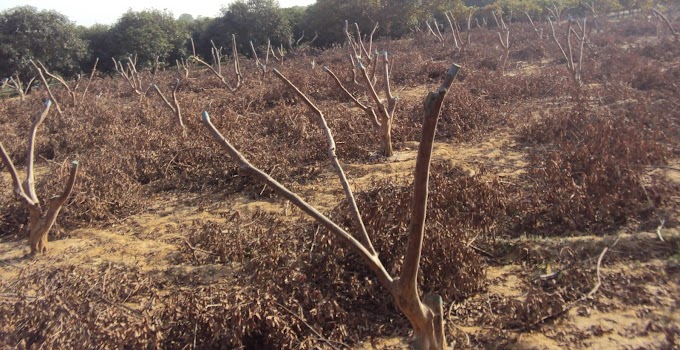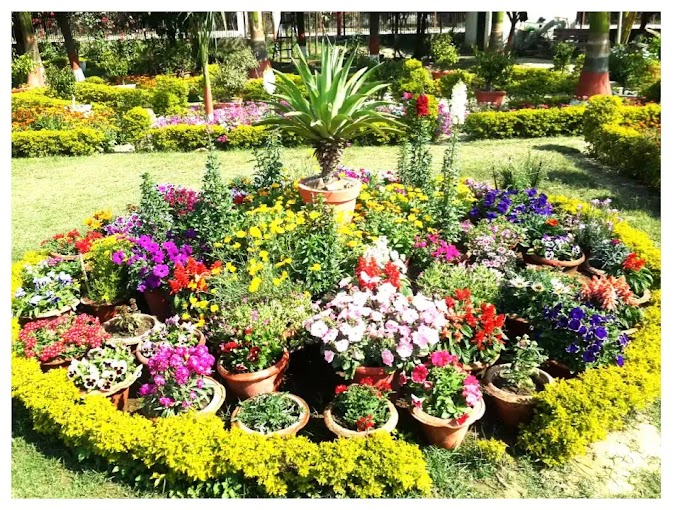The selection of a system for planting depends on the conditions and topography of the orchard’s location, plant species to be planted and orchards management practices. The systems of planting are also called systems of layout and none system is ideal for planting of fruit plants in all conditions. There are following systems of planting commonly used for planting of fruit trees:
1. Square system: This is a common system of planting adopted in plains. The distance from plant to plant and row to row is kept equal. The planting is done at each corner of the squares.
The square system of the layout is easy to draw and provides equal space to each fruit plant. The
space at the center of square remains unutilized which is the main demerit of the system. The accommodation of total number of plants in a given area is calculated as follows:
Total number of plants=(area of the land)/(plant to plant distance×row to row distance )
space at the center of square remains unutilized which is the main demerit of the system. The accommodation of total number of plants in a given area is calculated as follows:
Total number of plants=(area of the land)/(plant to plant distance×row to row distance )
2. Rectangular system: In this system of planting row to row distance is kept more than the plant to plant distance. The planting is done at each corner of the rectangles.
Rectangular System
The main disadvantage of the system is a greater loss of income in case of no practice of intercropping. The accommodation of plants can be calculated as follows:
Total number of plants=(area of the land)/(plant to plant distance×row to row distance )
3. Diagonal or Quincunx system: The quincunx system has been developed to utilize the space between four trees that remains unutilized in the square system. The planting is done similar to the square system except an additional plant is planted at the center of the square. The main crop is called primary fruit crop and filler crop is called secondary or supplementary fruit crop.
The income is increased and the growth of the weeds is suppressed. The acute competition between primary and filler fruit crops for water, nutrients, sunlight and air along with overlapping of branches and overcrowding of trees are the disadvantages of the quincunx system of planting. The number of plants requires to plant the available land can be calculated by following formulae:
The income is increased and the growth of the weeds is suppressed. The acute competition between primary and filler fruit crops for water, nutrients, sunlight and air along with overlapping of branches and overcrowding of trees are the disadvantages of the quincunx system of planting. The number of plants requires to plant the available land can be calculated by following formulae:
Total number of plants=[(area of the land)/(plant to plant distance×row to row distance )]×2
4. Triangular system: The triangular system is similar to the square system; the only difference is that the trees in the alternate rows are planted in the middle of the two corners of the squares whereas in the alternate rows also planting is done at the corners of the squares in the square system of planting. Thus trees are planted at the corners of triangles whose base and altitude are kept equal in length the one corner of such six isosceles triangles meeting at the same point to form a hexagon whose all six sides and angles are not equal in length and degree, respectively. The six trees are planted at the six corners and seventh tree at the midpoint of the hexagon.
Triangular System
The distance between rows and trees remains same. The accommodation of the plants is slightly lesser than the square system.
5. Equilateral Triangular or Hexagonal system: In this system of planting fruit trees are planted at the corners of triangles have all sides equal in length and are called equilateral triangles. The one corner of six equilateral triangles meets at a point and forms hexagon whose all six sides and angles are equal in length and degree, respectively. The six plants are planted at the six corners and seventh at the midpoint of the hexagon.
Hexagonal System
The 15% more trees could be accommodated in the hexagonal system than square system if the distance between rows and trees remains equal.
Total number of plants=(area of the land)/(area occupied by single plant )
Area occupies by single plant=3⁄4×A×A ×2
Area occupies by single plant=3⁄4×A×A ×2
Where, A= length of a side of triangle or spacing between plants
6. Contour system: The contour is an imaginary line connecting the points of equal height on a slope. This system has been evolved for the planting of fruit trees on hilly and slopes topography with the objective to minimize the soil erosion. The trees are planted on the bench terrace prepared on the contour. The one row of shrubs and grasses may be planted between two rows of fruit trees to reduce water flow and thereby soil erosion more effectively. The double hedge system accommodates about 22% more plants than single hedge system.
The number of plants accommodates in contour system can be calculated by following formulae:
The number of plants accommodates in contour system can be calculated by following formulae:
Total Number of Plants= N x Area / D (H+V)
Where,
N=Number of hedges, D= distance between plants, H= distance between hedges,
V= vertical distance between rows
V= vertical distance between rows
7. Freestyle system: When planting of fruit plants is done without following any regular geometrical layout design, the system is termed freestyle system. This system is followed to plant the fruit trees on homestead lands, public building’s compounds, wastelands, ravines, along railway tracks, rivers, coastal areas, factories etc.













